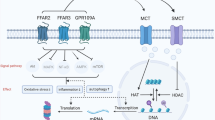Abstract
This study aimed to investigate the direct effects of advanced glycation end products (AGEs) on the mitochondrial structure and function of SH-SY5Y cells and the possible molecular mechanism(s) underlying mitochondria dysfunction by AGEs. SH-SY5Y cells were cultured in 400 μg/ml of AGE-bovine serum albumin (BSA) for 24 h, and changes in the mitochondrial function of SH-SY5Y cells were analysed as follows. Reactive oxygen species (ROS) were detected using 2′,7′-dichlorodihydrofluorescein diacetate molecular probes. Mitochondrial membrane potential (ΔΨm) was determined by flow cytometry using fluorescent probes. The expression of cytochrome c (Cyt c) protein level was assessed by Western blotting. Mitochondrial structures were observed by transmission electron microscopy. Our results showed that AGE-BSA induced an increase in ROS levels, a decrease in mitochondrial ΔΨm, and the release of Cyt c from mitochondria in SH-SY5Y cells. The mitochondria of SH-SY5Y cells showed remarkable swelling and vacuolisation, but these changes were recovered after pretreatment with neutralising anti-receptor for advanced glycation end products (RAGE) antibody. Our results suggested that AGE-BSA induced mitochondrial dysfunction in SH-SY5Y cells through RAGE pathways. Thus, AGEs are potential mechanistic links between diabetes mellitus and Alzheimer’s disease.





Similar content being viewed by others
References
Caldeira GL, Ferreira IL, Rego AC (2013) Impaired transcription in Alzheimer’s disease: key role in mitochondrial dysfunction and oxidative stress. J Alzheimers Dis 34:115–131
Distelmaier F, Valsecchi F, Forkink M et al (2012) Trolox-sensitive reactive oxygen species regulate mitochondrial morphology, oxidative phosphorylation and cytosolic calcium handling in healthy cells. Antioxid Redox Signal 17:1657–1669
Gasic-Milenkovic J, Loske C, Munch G (2003) Advanced glycation endproducts cause lipid peroxidation in the human neuronal cell line SH-SY5Y. J Alzheimers Dis 5:25–30
Guglielmotto M, Aragno M, Tamagno E et al (2012) AGEs/RAGE complex upregulates BACE1 via NF-kappaB pathway activation. Neurobiol Aging 33:196, e13-27
Hirai K, Aliev G, Nunomura A et al (2001) Mitochondrial abnormalities in Alzheimer’s disease. J Neurosci 21:3017–3023
Ishibashi Y, Yamagishi S, Matsui T et al (2012) Pravastatin inhibits advanced glycation end products (AGEs)-induced proximal tubular cell apoptosis and injury by reducing receptor for AGEs (RAGE) level. Metabolism 61:1067–1072
Kim GS, Jung JE, Narasimhan P et al (2012) Release of mitochondrial apoptogenic factors and cell death are mediated by CK2 and NADPH oxidase. J Cereb Blood Flow Metab 32:720–730
Lee HJ, da Lyu H, Koo U et al (2011) Inhibitory effect of 2-arylbenzofurans from the Mori Cortex Radicis (Moraceae) on oxygen glucose deprivation (OGD)-induced cell death of SH-SY5Y cells. Arch Pharm Res 34:1373–1380
Li J, Donath S, Li Y, Qin D, Prabhakar BS, Li P (2010) miR-30 regulates mitochondrial fission through targeting p53 and the dynamin-related protein-1 pathway. PLoS Genet 6:e1000795
Liang J, Yu Y, Wang B et al (2013) Ginsenoside Rb1 attenuates oxygen-glucose deprivation-induced apoptosis in SH-SY5Y cells via protection of mitochondria and inhibition of AIF and cytochrome c release. Molecules 18:12777–12792
Liu YY, Nagpure BV, Wong PT, Bian JS (2013) Hydrogen sulfide protects SH-SY5Y neuronal cells against d-galactose induced cell injury by suppression of advanced glycation end products formation and oxidative stress. Neurochem Int 62:603–609
Pasquier F, Boulogne A, Leys D, Fontaine P (2006) Diabetes mellitus and dementia. Diabetes Metab 32:403–414
Pazdro R, Burgess JR (2012) The antioxidant 3H-1,2-dithiole-3-thione potentiates advanced glycation end-product-induced oxidative stress in SH-SY5Y cells. Exp Diabetes Res 2012, 137607
Sasaki N, Toki S, Chowei H et al (2001) Immunohistochemical distribution of the receptor for advanced glycation end products in neurons and astrocytes in Alzheimer’s disease. Brain Res 888:256–262
Schmidt AM, Yan SD, Yan SF, Stern DM (2001) The multiligand receptor RAGE as a progression factor amplifying immune and inflammatory responses. J Clin Invest 108:949–955
Shi L, Yu X, Yang H, Wu X (2013) Advanced glycation end products induce human corneal epithelial cells apoptosis through generation of reactive oxygen species and activation of JNK and p38 MAPK pathways. PLoS One 8:e66781
Sims-Robinson C, Kim B, Rosko A, Feldman EL (2010) How does diabetes accelerate Alzheimer disease pathology? Nat Rev Neurol 6:551–559
Wang X, Su B, Zheng L, Perry G, Smith MA, Zhu X (2009) The role of abnormal mitochondrial dynamics in the pathogenesis of Alzheimer’s disease. J Neurochem 109(Suppl 1):153–159
Wang X, Yu S, Hu JP et al (2013) Streptozotocin-induced diabetes increases amyloid plaque deposition in AD transgenic mice through modulating AGEs/RAGE/NF-kappaB pathway. Int J Neurosci 2013 Dec 12
Zhao Y, Zhao B (2013) Oxidative stress and the pathogenesis of Alzheimer’s disease. Oxidative Med Cell Longev 2013, 316523
Acknowledgments
The study was supported by the Natural Science Foundation of China (81100810, 81203004) and the Postdoctoral Science Foundation of China (2013M540234).
Author information
Authors and Affiliations
Corresponding author
Additional information
Editor: T. Okamoto
Rights and permissions
About this article
Cite this article
Wang, X., Yu, S., Wang, CY. et al. Advanced glycation end products induce oxidative stress and mitochondrial dysfunction in SH-SY5Y cells. In Vitro Cell.Dev.Biol.-Animal 51, 204–209 (2015). https://doi.org/10.1007/s11626-014-9823-5
Received:
Accepted:
Published:
Issue Date:
DOI: https://doi.org/10.1007/s11626-014-9823-5




